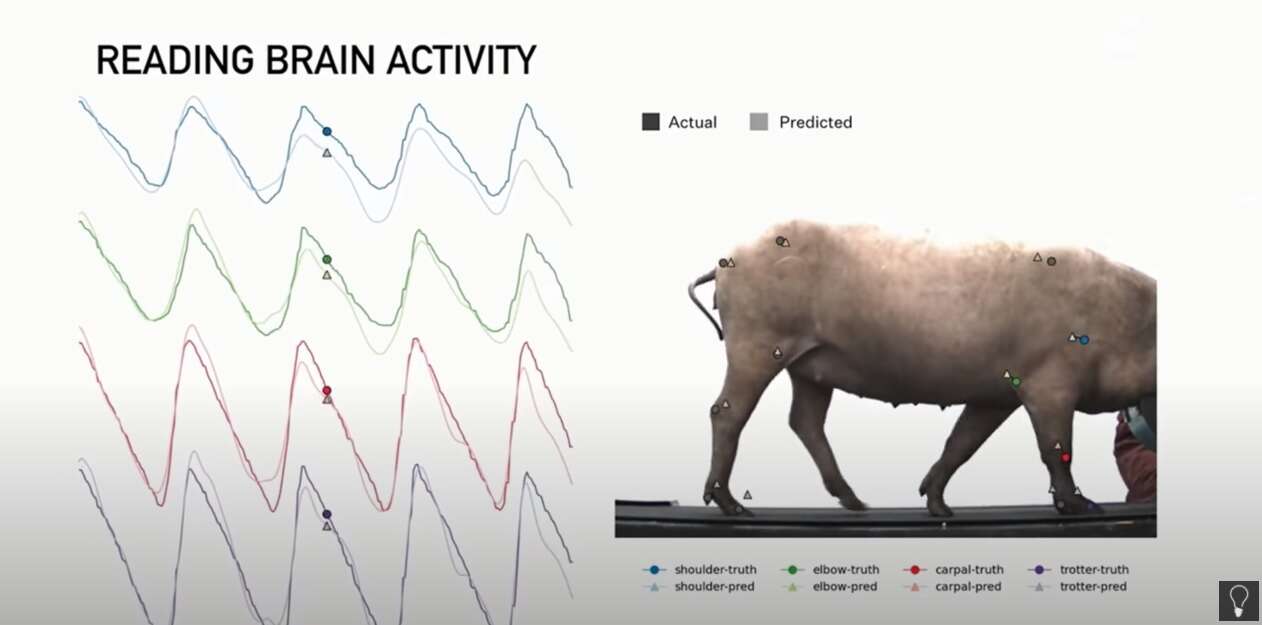
For those of you who didn’t catch it, Elon Musk’s much-hyped Neuralink update was a strange cross between a press conference and a Vaudeville act, as the CEO wheeled out different pigs in various states of connection with his company’s Brain Machine Interface device, to present to his audience.
The onlookers, seated at the individual round tables normally reserved for dinner theatre, were treated to the melodic bleeping sound of Gertrude the pig’s brainwaves as what looked like ragtime sheet music, the data coming from the chip in Gertrude’s snout, was projected onto the screen.
The Neuralink chip is a tiny 23 mm across chip, described by Musk as “a Fitbit for the skull with tiny wires”. The chip can access 1024 channels, and one electrode (a sensor that penetrates the brain) is the size of one 20th of one hair. It operates via bluetooth and can be accessed by a smartphone.
The robot that sews electrodes into the brain seems to operate successfully and may be able to perform operations without human oversight in the future. The company has received a breakthrough designation by the FDA for its research.
See our detailed look at the technology >> here <<
Yet most of the experienced neurologists and other sector experts approached by Computer Business Review for reaction were non-plussed.
Dr John Krakauer, Professor of Neurology, Neuroscience and Physical Medicine and Rehabilitation at the Johns Hopkins University School of Medicine, was dismissive “It was science-lite. Honestly, there’s no question about that. And to fill the space of the science, which wasn’t really there, they started making claims that one day humans will hybridised with A.I. and that people will talk to machines.
“It’s that sort of consumer language that has everyone excited” he continued. “I think there are a lot of extremely competent engineers and scientists at Neuralink. But there’s a slight whiff of the salesman… I think what I object to the most is that the best use of the technology, as they themselves admit, will be medical. And yet what they really want is a consumer device. It’s that uncomfortable dialectic between the medical gateway, but the consumer promise that I have the most trouble with”.
What was Missing?
Postdoctoral researcher at Swiss Federal Institute of Technology in Zurich, Giacomo Valle, who has a PhD in Biorobotics, said to Computer Business Review: “There were no data or statistics shown to demonstrate the real benefits and improvements of this technology, compared with a Utah array [a more popular form of electrode] for example, and there was no scientific demonstration.
“There was no mention of issues like tissue reaction or biocompatibility being solved, and since the electrodes are planar (multi point stimulation) there is a possible difficulty in reaching deep structures for stimulation and recording selectively. I found the discussion of algorithms necessary to decode /encode the information from/to the brain to be poor, as there was an over-reliance on spikes in brainwave activity”.
The “spikes” were not mentioned in the initial presentation, but were in a question from Twitter that was answered afterwards by the Neuralink team.
“I would have liked to have seen recordings of movement-command related signals” explained Dr Robert Kirsch PhD, Chairman of the Department of Biomedical Engineering at the Case Western Reserve University and Executive Director at the Functional Electrical Stimulation (FES) centre in Cleveland.
“It appeared that all the data they showed, in real time, which was actually very impressive, was sensory. This is sufficient to show that the devices all work and to show safety, but not really aligned with many of the proposed applications. The motor signals are presumably coming when they implant people.
Read This: Your Brain, With a USB Port in It: Elon Musk’s Neuralink Vision Divides Experts
“They could have demonstrated the electrodes implanted deeper than a few millimetres” continued Dr Kirsch. “They claim they can do this, but have not done this yet. The potential for doing this in people in the near term is unique to their system. Presumably they are working on this”.
Oliver Armitage, CSO and co-founder of the full-stack neural interface platform BIOS, said: “The work demonstrated was slick but not in itself novel – copying the kind of experiments done in neuroscience labs for decades.
“However,” Armitage continued, “the real advances in neuro technology are now being made in terms of the software and algorithms for understanding neural data. Unfortunately, in terms of understanding and using the neural data for important applications, such as improving health, Neuralink has not shown any advances.
“In fact, by having only just developed a long term implant, they have shown that they are three to five years behind other companies”.
Dr Krakauer’s frustration, meanwhile, shone through: “We are in a position right now, based on the kind of software and hardware available, where people’s chances of recovering after many forms of brain injury and brain disease could vastly improve. We should be putting pressure on insurers and doctors to vastly improve the quality of rehabilitation and restorative therapy” he said passionately.
“Instead of journalists covering the need to vastly improve peoples’ quality of care with the current quality of technology; it’s just Neuralink! Neuralink! Neuralink”!
Don’t Leave Before You’ve Read This: Pssst: Want to be NATO’s Next CIO?






